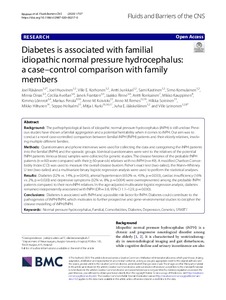Diabetes is associated with familial idiopathic normal pressure hydrocephalus: a case-control comparison with family members
Mikko Kauppinen; Markus Perola; Janek Frantzen; Juha E. Jääskeläinen; Minna Oinas; Simo Komulainen; Joel Räsänen; Mitja I. Kurki; Sami Kastinen; Hilkka Soininen; Ville E. Korhonen; Antti Junkkari; Anne M. Remes; Anne M. Koivisto; Joel Huovinen; Kimmo Lönnrot; Antti Ronkainen; Jaakko Rinne; Mikko Hiltunen; Ville Leinonen; Seppo Helisalmi; Cecilia Avellan
Diabetes is associated with familial idiopathic normal pressure hydrocephalus: a case-control comparison with family members
Mikko Kauppinen
Markus Perola
Janek Frantzen
Juha E. Jääskeläinen
Minna Oinas
Simo Komulainen
Joel Räsänen
Mitja I. Kurki
Sami Kastinen
Hilkka Soininen
Ville E. Korhonen
Antti Junkkari
Anne M. Remes
Anne M. Koivisto
Joel Huovinen
Kimmo Lönnrot
Antti Ronkainen
Jaakko Rinne
Mikko Hiltunen
Ville Leinonen
Seppo Helisalmi
Cecilia Avellan
BMC
Julkaisun pysyvä osoite on:
https://urn.fi/URN:NBN:fi-fe2021042821153
https://urn.fi/URN:NBN:fi-fe2021042821153
Tiivistelmä
Background The pathophysiological basis of idiopathic normal pressure hydrocephalus (iNPH) is still unclear. Previous studies have shown a familial aggregation and a potential heritability when it comes to iNPH. Our aim was to conduct a novel case-controlled comparison between familial iNPH (fNPH) patients and their elderly relatives, involving multiple different families.
Methods Questionnaires and phone interviews were used for collecting the data and categorising the iNPH patients into the familial (fNPH) and the sporadic groups. Identical questionnaires were sent to the relatives of the potential fNPH patients. Venous blood samples were collected for genetic studies. The disease histories of the probable fNPH patients (n = 60) were compared with their >= 60-year-old relatives with no iNPH (n = 49). A modified Charlson Comorbidity Index (CCI) was used to measure the overall disease burden. Fisher's exact test (two-tailed), the Mann-Whitney U test (two-tailed) and a multivariate binary logistic regression analysis were used to perform the statistical analyses.
Results Diabetes (32% vs. 14%, p = 0.043), arterial hypertension (65.0% vs. 43%, p = 0.033), cardiac insufficiency (16% vs. 2%, p = 0.020) and depressive symptoms (32% vs. 8%, p = 0.004) were overrepresented among the probable fNPH patients compared to their non-iNPH relatives. In the age-adjusted multivariate logistic regression analysis, diabetes remained independently associated with fNPH (OR = 3.8, 95% CI 1.1-12.9, p = 0.030).
Conclusions Diabetes is associated with fNPH and a possible risk factor for fNPH. Diabetes could contribute to the pathogenesis of iNPH/fNPH, which motivates to further prospective and gene-environmental studies to decipher the disease modelling of iNPH/fNPH.
Kokoelmat
- Rinnakkaistallenteet [19218]
